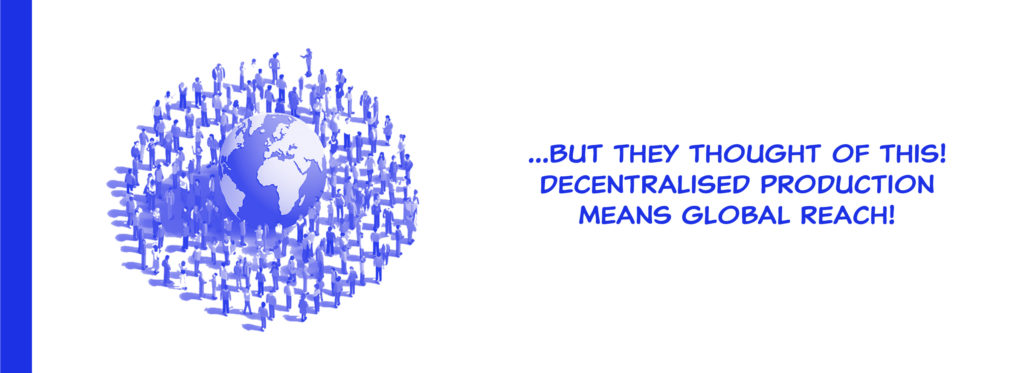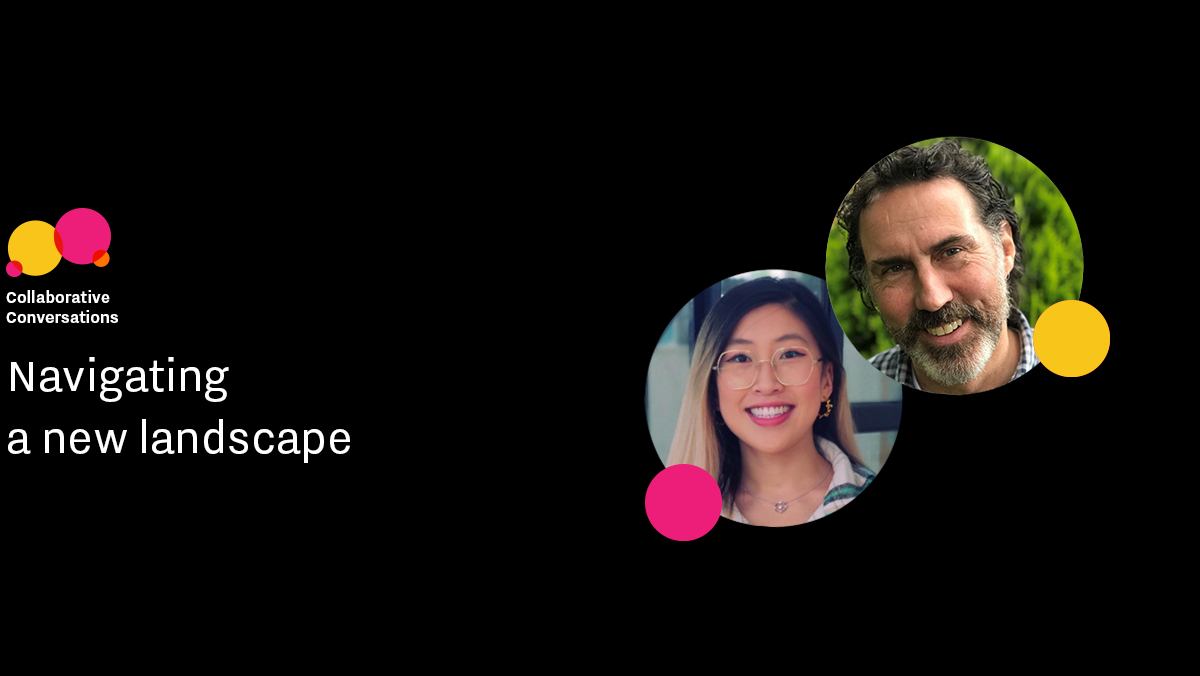The pandemic may be over but the fallout continues to affect businesses. Product refresh has shifted to product innovation, and on much shorter cycles. The focus today is more about pivoting to deal with situations, rather than riding through them. In this changed – and changing – world, the environment is even more in focus, consumer needs are in flux, and uncertainty seems to grow all the time. In this GW+Co Collaborative Conversation, we explore how businesses can navigate this complex territory and make a profit, while retaining the ‘license to operate’ that comes from being aligned with social and environmental concerns.
Gilmar: Today I’m pleased to welcome Michelle Chow and Gavin Anderson. Michelle is a project manager, an avid gamer, and a user of social media, and Gavin is into all things digital innovation. The two have worked together with me on a couple of projects, so we know each other quite well. We’re going to talk about transformations hide in plain sight in the realm of product innovation. We sat down to have this conversation almost exactly three years since COVID-19 was declared a pandemic, and we all had to adjust to a new life. It seemed as if half the world was working from home. Tools like Zoom, Microsoft Teams, and so on, experienced huge spikes in usage. Share prices went through the roof for these companies, as for many digital companies. ‘Exponential’ and ‘unprecedented’ were the words of the day. Businesses had to pivot. Product innovation cycles went from 400 days to 90 days. So, fast-forward three years. It’s 2023, the pandemic is over, but the world has changed. Will we ever go back to where we were before?

Gavin: I think it’s driven by need. The pandemic created the kind of acceleration we haven’t seen since the Second World War. That was a fight for existence, so the development of things like the jet engine and radar, which could have taken many years, were compressed into very short periods. Although we weren’t at war three years ago, the pandemic accelerated product innovation, for instance in the speed with which the vaccine was developed. But it also changed things, because we all changed our behaviours. We stopped going to offices, buying sandwiches at lunchtime, or meeting our friends down the supermarket. But we still had to get up each morning and have a shave or use some deodorant, do those functional things with products that we couldn’t get to the store for. The trend for products-as-a-service, or as an outcome rather than output, was driven throughout the pandemic by human needs.
Michelle: Just to follow on from that, as we’re focusing on the opportunities that the pandemic opened up, it helped social selling – basically, using social media to find and connect with customers – to identify a huge market gap. This led to the growth of the Direct-to-Consumer world. D2C has made it viable to sell through authentic reviews and other entirely free word-of-mouth channels, without the consumer even trying a product. That’s something few would have placed any trust in

Gilmar: Amazon reviews have been around for a while, though. Is this a trend that has happened over time?
Michelle: I wouldn’t necessarily include Amazon reviews in this, because they can be a bit hit and miss, such as where people are paying to get good reviews. But now there’s Trustpilot for companies, there’s Glassdoor, and so on, and they rely heavily on authenticity to promote reviews so that people see them as reliable. This touches on influencer marketing, which we can go into later. But in terms of product innovation, I like the fact that ordinary people have become part of the marketing process. There are a lot of people who don’t necessarily have an ‘influencer platform’, but because they can use these review websites they do have the ability to share what they think.
Gilmar: In our preparation for this conversation you identified four top drivers of innovation, and we’ve touched on the first one, social selling. Then there’s the pandemic itself, followed by environmental motivations, as well as wider concepts of sustainability. I’d like to understand these trends, why they matter, and what we should do about them.
Gavin: Michelle is right that during the pandemic social selling, social influence, and the growth of social media all accelerated product innovation. Things like Harry’s Shaving company, where you subscribe online to buy your razors and so on. They had a bit of take-up before, but the pandemic nailed it because it means I don’t need to go to the shops to buy my favourite moisturiser and everything. Things that were previously a nice alternative became mainstream, and people realised they could replace the time it would take to go to the shop and buy a razor with time at home with the wife, children, cat, garden, whatever. So, for Gillette to get me to go to Tesco’s and spend time looking at a product rack would take something more than product innovation – or, as in the case of Harry’s, service innovation.
Gilmar: Some of the bigger brands are being very innovative with products too, aren’t they?
Gavin: Sure. For my birthday this year my family bought me a new bottle of aftershave in a big, thick glass bottle, as you’d expect. But guess what Dior did? They still have the lovely packaging, and a little insert to hold it down, all that luxury presentation. The difference is that this one plugs into my existing bottle of aftershave and it’s made out of recycled aluminium. This is product innovation, but without asking consumers. It reduces the packaging from two glass bottles down to one small tin, and that’s a functional improvement. But for me, as a typical member of the target market, I think it’s great, so I feel good about it. If you like, they’ve already got me before I knew I needed that innovation. When we talk about hidden transformations, that’s a great example. It’s a massive, unannounced change in manufacturing, a really interesting way for big brands to do product innovation. It ticks lots of boxes – improved profit margin, improved brand experience, improved environmental sustainability. Today, it’s not just about being quicker, faster, better, but about all those things – plus a more enjoyable experience, more sustainable, more accountable, more transparent. And, therefore, a more balanced experience of brand and product.
Gilmar: So, that’s two things. One is the external driver that gave Harry’s Shavers a lucky break, in a way. Although, presumably, you could buy Gillette razors from Amazon and get them delivered.
Gavin: But that’s not offering a new proposition to the consumer. If I buy my Gillette from Amazon it’s one stage removed, and that commoditises Gillette’s product by saying, ‘I want the three or the five, which is the cheapest, delivered by tomorrow’, and it’s clicked and done. There are many brands that now offer a home delivery service, and they work hard to engage you, so it is not just about being cheaper, faster, better, it’s about the advice and the knowledge. If Gillette had said, ‘sign up to our shaving blog, to understand about all things shaving’ I probably wouldn’t have signed up to it. But Harry’s has more a direct relationship with me. They’re saying, ‘hey, we’re going to sort out the pricing for you, we’ll sort out the frequency of delivery for you, we’re able to sort out the type of shaving foam that you need. And when your shaving foam changes as you get older’ – as some of us do – ‘we’ll send you a different shaving foam’. The connection with the brand experience is as much to do with the innovation.

Gilmar: Let’s talk some more about social selling. What do we need to know about that?
Gavin: This is a case of two ends of the telescope. From my end, it’s very much a marketing function, but Michelle’s of the generation that takes the advice of their friends over the advice of the ads. They don’t ask their mum or dad which is the best Hoover to buy, they ask their friends. When we talk about social selling, there are the influencers – here’s a famous person with that particular brand’s bag over their shoulder – but it’s also at a micro level where it’s your friends, your small peer group. And the values they have will be reflected in your purchases. So, if you are in a group that values being ethical, your product purchases will probably be ethical – not driven by the brand, driven by your peers and their influence. Social selling has been seen as influencers telling people to buy things, but actually social selling is also influencer groups allowing those positive discussions to happen. However, strangely enough, some brands still think they can pull the wool over the eyes of the Gen Ys and the Gen Zs.
Michelle: That’s a great point, because I rely on social selling to determine the purchases I make. I don’t necessarily listen to influencers, because I don’t always know if they’re being paid to say something. We see people promoting products for certain brands and saying they’re so good, but we also want to see videos where influencers are naming the products they won’t use. That helps them with their own personal brand, because it lends authenticity to them in the eyes of their viewers. I think the importance of social selling is greater than marketing in general. There was a survey recently that said 61% of consumers trust influencers’ recommendations, whereas 31% trust brands’ social media content, because influencers have a human face, they’re someone consumers can relate to. The long-standing reputation of brands is that they just want to generate money, they promote the things they want consumers to want.

Gilmar: What’s a good example of social selling?
Michelle: Well, there’s an interesting story about a company making bikinis. They were looking to market their product, but didn’t have enough budget to do the type of influencer promotion they felt they needed. Their ideal influencer was Kendall Jenner, but they couldn’t afford to pay her fees. What they did was send free products to her circle of friends – but not to her! This created FOMO, the fear of missing out, and Kendall Jenner herself eventually reached out to the company and said, ‘you know what, all my friends have this bikini, why don’t I have one?’ So they sent her one, and from that point on she posted about it on her social media channels. It helped generate a lot of revenue for the company. So I think social selling does work, on influencers as well as on ordinary consumers.
Gavin: I think that makes a really interesting cultural point. As an influencer, if you become too detached from the lived reality of people’s culture, too much like a celebrity as it were, your influence actually wanes. Whereas those who are down on the ground and being authentic about things get sold as bullet-proof. It makes influencer marketing more complex, and it means we’re long past the days when an agency could just hire an influencer based on their number of followers and pay them whatever per tweet.

Gilmar: We talked about the question of authenticity, and the difficulty for brands if they aren’t seen as authentic, and now we have influencers trading on their authenticity to become brands themselves. Their influence has become harder to buy, because they’re much more aware of how they might be perceived by their followers. So they talk more about things they won’t do, to stake out the territory of what they do stand for. Does that make things harder for brands, or in fact easier, because now you’ve got people with followers to recruit, as well as a following based on values.
Michelle: I think it’s harder for brands. It reminds me of another story, about Gymshark. When they started out they hired a lot of influencers who were super-fit, athletes with six-pack stomachs, the whole ripped body thing. But they realised that many of those influencers weren’t really healthy, they were putting themselves through a lot of pain and stress to look ‘perfect’, and they were getting called out on social media. So Gymshark had to change the way they were doing things and adopt a new mindset, changing their whole approach to present real people training, to show their products are actually usable, and that as a brand they’re relevant and accessible to ordinary people. I think it shows that social selling goes both ways – brands can influence people and, increasingly, people can influence brands too.

Gilmar: It can be a fickle world then, and you have to be really careful that what you are promoting stands up to scrutiny. And it’s not just scrutiny in the sense of ESG committees and so on, but the scrutiny of the people – social scrutiny, if you like.
Gavin: It partly explains the shift from profit-led purpose to human-led purpose. The pandemic saw many brands decide to do things that they probably wouldn’t have done before and, strictly speaking, didn’t have to, like reaching out to and supporting communities and causes and so on. And in many cases they have benefitted financially from being seen as a company that stood up for ‘the people’ at the time. That influenced product and service innovation, which had to adapt to the changes in consumer behaviour imposed by lockdown restrictions, but now that has created new expectations for consumers. For example, almost everyone uses wireless ear buds now, but we used to manage with those cheap wired ones, even if we had to spend ages untangling them every time the phone rang. But the market is never going back, because the innovations keep coming – now they’re rechargeable, now they’ve got noise cancellation, they’ve got voice management. A friend of mine even uses them as hearing aids.

Gilmar: Just going back to the impact of the pandemic, I was on a webinar recently and I asked the group whether they’d actively managed the ongoing issues around remote working, or whether it has just kind of happened to them. And the majority said it has just happened to them. That’s creating some problems. People are asking if they should go back to full-time in the office, or what combination of days in and out, and so on. At the same time, we‘re seeing these changes in product innovation, partly about speed but also authenticity, about keeping people onside by reflecting their values. What is needed on the organisational side to follow through on these issues? What impact have they had on organisational structures? What must they do to keep pace with change now?
Gavin: In a nutshell, decentralise. In the previous 20 years, manufacturing was becoming more and more centralised. If you had ten factories they’d be centralised into five, then centralised into one. That’s why your iPhone is made in China, your bicycle is made in Thailand, and your car is made in South America. You can see this centralisation curve in the way office work has evolved too. But centralisation doesn’t always add value, and often creates unecessary layers of bureaucracy. We’re not going to go into all the stuff about holacracy and decentralised teams here, but there are some great examples emerging in manufacturing. For example, the French social enterprise Les Mains de Mamie employs a network of grannies (as they call them) to create handmade jumpers based on your choice of design and colour and size. The actual business is just a handful of people with no offices, and it’s growing into a multi-million pound manufacturing business. So I think decentralisation of manufacturing, and of services, is a big thing.

Michelle: It’s another aspect of what businesses learned from the pandemic, that there’s a human behind the role. Pre-pandemic we would all work 9 til 6, grind it out, and go home really tired, maybe just fall asleep on the couch. Since the pandemic, as well as changing their working patterns, a lot of people have been losing or quitting their jobs. Meanwhile, supply chains were disrupted, so companies started looking for solutions closer to home. A big part of that is the human aspect, attracting and retaining talent, and the pandemic really put the spotlight on culture. Decentralised working has been extremely helpful in that respect, and in my opinion this workforce innovation, if you want to call it that, is something that organisations can also focus on, to match consumers’ interests in authenticity, in ethical and sustainable practices.
Gavin: We should also touch on the impacts of innovation. I live in a rural area, and the fastest growing retail sector in the UK in the last three years is farm shops. They’ve obviously benefitted from the big increase in the sustainability agenda, the demand for seasonal produce with low food miles, etc., and actually the move to shopping locally has been a positive impact. It’s another example of decentralisation. Why not go to a local shop instead of a supermarket the size of a football field that will try to sell you a jet washer next to the cauliflower? Now we’re seeing the return of smaller retailers who can innovate quicker and deliver locally. It’s a mix of the changing values since the pandemic, a desire for solutions, and a growing intolerance of brands that might not be telling the truth, creating a burning platform that is essentially innovate or die. Whether it’s a cool start-up or an agile team in a large corporate, it doesn’t matter if they move at the same speed, they just have to move, you can’t wait. We’re seeing business that aren’t relevant anymore just disappearing.
Gilmar: So, a lot to chew on there! Thank you both very much.
See you next time!
What’s next?
Want to know more about GW+Co? Have a chat with Olivia
Have a question? Ask a question of one of the authors – Michelle or Gavin
Have a strategic problem? Walk with Gilmar

